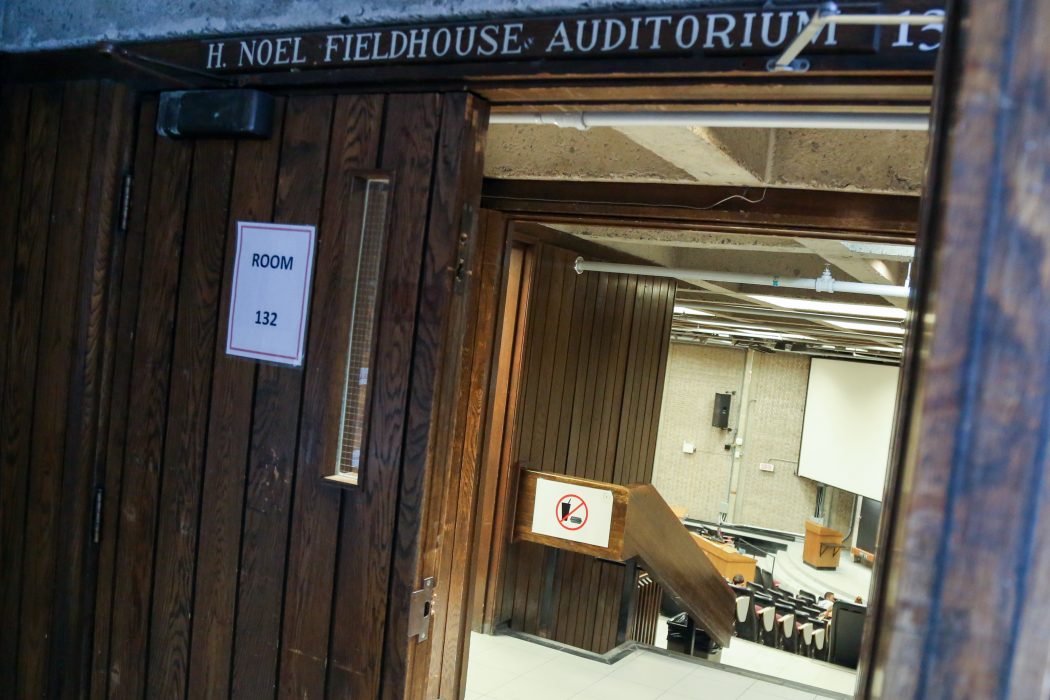So, you have a lecture in Leacock 132. Don’t worry, nearly every student suffers through at least one of these nap-inducing introductory classes during their time at McGill. However, what some people don’t realize is that in classes like these, it takes more than diligent note-taking and a studious attitude to survive this class; it’s imperative to have a nuanced understanding of Big-Lecture etiquette.
In every class there are a handful of students who mistake the lecture hall for an intimate conference and unwittingly assign themselves the role of class nuisance by refusing to adhere to auditorium protocol. But fear not, with the appropriate knowledge of Big-Lecture etiquette and a modicum of respect for those around you, you can make it through the class without ever finding yourself at the receiving end of an eyeroll. Here are some of the most common Big-Lecture faux-pas and tips on how to avoid them:
it takes more than diligent note-taking and a studious attitude to survive this class; it’s imperative to have a nuanced understanding of Big-Lecture etiquette.
Refrain from Self-Serving Questions
For most students, asking a question in front of the class is a terrifying experience. You must be truly confident in the universality of your confusion to interrupt the professor, ask a question, and believe it was worth the 30 seconds of class time that your fellow students will never get back. This pressure generally restricts class participation to nearly non-existent levels, but there are always a few students who do not grasp this concept and use a lecture as an opportunity to practice their public speaking skills. While students occasionally ask clarifying questions that positively contribute to the lecture, the vast majority of raised hands either lead to badly thought-out ramblings or an attempt to wow the class with their deep understanding of the material. Simple rule of thumb: if your question contains a personal anecdote, begins with “I’m just trying to work out…” and ends with “Does that make any sense?”, or if it isn’t a question at all, keep it to yourself. 600 students did not show up to class to hear an undergraduate opinion on a subject that the professor has spent their entire adult life studying. If the urge to show off is just too strong to resist, perhaps write down your insights into the notebook margins. Or better yet, head on over to office hours! That’s what they’re there for! Your furious scribbling will be more intellectually intimidating to the people sitting beside you than any verbal comment could be, anyway.
Be Aware of Your Surroundings
When a butterfly flaps its wings, it can cause a tornado on the other side of the world. When a student bounces their leg in an auditorium, the vibrations can be felt throughout the entire row. Some everyday actions have unforeseen impacts when performed in a big auditorium and can be majorly annoying to the rest of the class. For instance, while obnoxiously loud foods like potato chips are just a tasty source of fuel in most scenarios, when consumed in Leacock 132 they are transformed into infuriating, crunchy distractions — auditorium acoustics considered. Despite this, some students seem compelled to eat the noisiest, smelliest possible foods, either unconcerned or unaware of the teeth-grinding their snack is provoking. Similarly, waltzing into a room 15 minutes late with Starbucks in one hand and a samosa in the other may be classified as “fashionably late” in some settings, yet this glamourous effect does not translate well in Leacock 132. Don’t make a grand entrance, don’t slowly weave through seats to sit with your friends in the middle of the row, knocking people out with your swinging backpack along the way. This is the time to access your inner ninja, stealthily scoping out the least disruptive aisle seat, and hope that no one notices your sneaky entrance.
Similarly, waltzing into a room 15 minutes late with Starbucks in one hand and a samosa in the other may be classified as “fashionably late” in some settings, yet this glamourous effect does not translate well in Leacock 132.
Sit Wisely
When picking a seat in Leacock 132, there are two big choices you have to make. The first choice is whether to sit at the front of the class or the back of the class. If you plan to spend class time messaging on your laptop, don’t sit in the front unless you’re okay with all the rows behind you reading over your shoulder, because they can and they will. Your gossip session is probably a more stimulating visual than PSYC 100 PowerPoint slides could ever be. The back of the class is also reserved for nappers, talkers, and online shoppers. If you get distracted by the back-row types or plan on asking a thoughtful, etiquette-abiding question, then the front of the class is probably for you. The second choice you must make is whether to take an aisle seat or a centre seat. If you know you will have to leave the lecture early, pick an aisle seat. Why would you subject yourself and your classmates to the awkward ordeal of squeezing through 20 pairs of knees when you could just elegantly slip out of an aisle seat? However, if you do choose an aisle seat, do not unfold your desk and set up your laptop before the aisle is filled. Chaos will ensue when students try to shimmy through the narrow pathway between the edge of your desk and the seat in front of you, while simultaneously leaping over your backpack and outstretched feet. That is how coffees are spilled, legs are burned, and lawsuits are filed.
Congratulations: you now have all training you need to face Leacock 132. Commenter Cody and Late Larry are unavoidable classmates, and they will make lectures occasionally intolerable, but practicing good auditorium etiquette will keep your own Big-Lecture reputation non-existent, just the way it should be.


